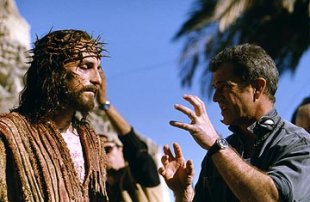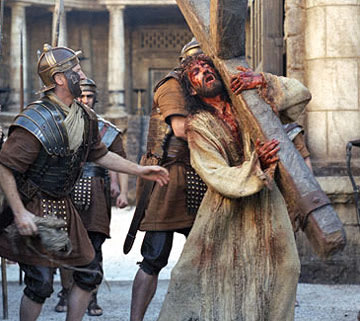8 Things You Didn't Know About ‘The Passion of the Christ’
Mel Gibson's "The Passion of the Christ" opened on Ash Wednesday, Feb. 25, 2004, immediately sparking the biggest religious-based movie controversy since ... well, since Martin Scorsese's "The Last Temptation of Christ" (1988).
An all-consuming labor of love for director/co-writer Gibson (to say the least), "Passion" chronicles the last 12 hours in the life of Jesus Christ (Jim Caviezel), from the Agony in the Garden through his death on the cross, with a brief epilogue focussed on the Resurrection. The film was a huge box office success, earning an astonishing $370,782,930 at the domestic box office, making it the highest-grossing R-rated movie of all time and the highest-grossing foreign language film released in the U.S.
Still, its release was met with a hailstorm of criticism; fierce debate raged around the violent recreation of the torture of Jesus, allegations that the film contained anti-Semitic passages (which, to quote James Southall of Movie Wave, is "kind of like saying 'Patton' is anti-German") and its depiction of King Herod as a fey fop holding a fool's court of decadent misfits.
Upon the 10-year anniversary of its release, here are 8 things you might not know about Gibson's moving, challenging masterpiece.
1. Some of the source material is controversial, too.
One of the main inspirations for co-screenwriters Mel Gibson and Benedict Fitzgerald was "The Dolorous Passion of Our Lord Jesus Christ," a tale in which poet Clemens Brentano chronicles the (supposed) visions of stigmatic German nun Anne Catherine Emmerich (1774-1824).
One of the main inspirations for co-screenwriters Mel Gibson and Benedict Fitzgerald was "The Dolorous Passion of Our Lord Jesus Christ," a tale in which poet Clemens Brentano chronicles the (supposed) visions of stigmatic German nun Anne Catherine Emmerich (1774-1824).
While it's been speculated that Brentano wrote most of the book himself, with a Vatican investigation concluding that "it is absolutely not certain that [Emmerich] ever wrote this," the book inspired some of the most striking images in the film, including the suspension of Jesus over the bridge after he's first taken into custody, the torment of Judas by demons, Mary's wiping up the blood of Jesus from the ground after his scourging and the dislocation of Jesus' right shoulder so that his hand could reach the hole for the nail on the cross.
2. It's also the most pro-Catholic movie of all time.
In 2004, the National Catholic Register and Faith & Family magazine gathered online nominations for films that best celebrate Catholic life (movies with specific Catholic references, not simply with Catholic themes). Over 1,000 readers voted, and "The Passion of the Christ came in at #1.
Interestingly enough, a few other Mel Gibson films made the list, including his 1995 directorial effort, "Braveheart" (#12), and his 2002 Vietnam War film, "We Were Soldiers" (#23), which was directed by "Braveheart" screenwriter Randall Wallace.
3. Mel Gibson footed the bill himself.
Mel Gibson shot the film without securing any outside funding or distribution.
Mel Gibson shot the film without securing any outside funding or distribution.
"This is a film about something that nobody wants to touch, shot in two dead languages [Aramaic and Latin]," said Gibson in a 2002 interview with the Hollywood Reporter. "In Los Angeles they think I am insane, and maybe I am."
Gibson's own Icon Productions supplied the entire production budget of $30 million, with an extra $15 million for marketing after Gibson decided to distribute the film in the U.S. himself via Newmarket Films. And that 'insanity' certainly paid off, as the film went on to earn over $611 million worldwide — with Forbes speculating that Gibson himself pocketed up to 50% of that amount.
4. That Oscar-nominated music almost never existed.
Lisa Gerrard ("Gladiator," "The Insider") composed and recorded a preliminary score for the film, but it was incomplete at the time of its theatrical release. The score featured in the film comes courtesy of John Debney (who's currently in pre-production on another Biblical epic, "Mary") and ended up being nominated for an Academy Award.
Lisa Gerrard ("Gladiator," "The Insider") composed and recorded a preliminary score for the film, but it was incomplete at the time of its theatrical release. The score featured in the film comes courtesy of John Debney (who's currently in pre-production on another Biblical epic, "Mary") and ended up being nominated for an Academy Award.
That Oscar nom probably helped assure Mel Gibson that he was right to change his mind about including music, as originally he considered having no musical score whatsoever for "The Passion of the Christ." This came from his "drive for authenticity" with the project, and "authenticity in the score would be very difficult since so little is known of the music of the period and what little is known would likely be unpalatable by a modern audience," as pointed out by James Southall in his review of Debney's score at Movie Wave.
5. Those subtitles almost never existed.
Nothing in "The Passion of the Christ" better represents Mel Gibson's "drive for authenticity" than the spoken dialogue, which is entirely in Aramaic and occasionally in Latin. Shooting in these two "dead languages" made it hard enough for Gibson to secure outside funding for the film, but what really made the project untouchable in Hollywood's eyes might've been Gibson's early decision to not include subtitles.
Nothing in "The Passion of the Christ" better represents Mel Gibson's "drive for authenticity" than the spoken dialogue, which is entirely in Aramaic and occasionally in Latin. Shooting in these two "dead languages" made it hard enough for Gibson to secure outside funding for the film, but what really made the project untouchable in Hollywood's eyes might've been Gibson's early decision to not include subtitles.
"Caravaggio's paintings don't have subtitles, but people get the message. The Nutcracker Ballet doesn't have subtitles, but people get the message. I think that the image will overcome the language barrier. That's my hope," said Gibson in a 2002 interview with Zenit.org.
"I'm just trying to be as real as possible," Gibson continued. "There is something kind of startling about watching it in the original languages. The reality comes out and hits you. Full contact. I know we are only re-creating, but we are doing the best we can to simulate an experience of really being there."
Gibson eventually felt that simulated experience could benefit from actually knowing exactly what everyone was saying and subtitles ended up being included in the completed film.
6. Jim Caviezel got hit by lightning (literally).
We guess that's a sign from God that he's doing a good job?
We guess that's a sign from God that he's doing a good job?
"I was lit up like a Christmas tree!," said Jim Caviezel in a 2004 interview with The 700 Club. "I was doing the Sermon on the Mount. I knew it was going to hit me about four seconds before it happened. I thought, 'I'm going to get hit.' And when it happened, I saw the extras grab the ground. What they saw was fire coming out the right and left side of my head. Illumination around the whole body. And during the shot they said, 'Do you have it on camera?'"
Unfortunately, that moment wasn't captured for posterity.
"What happened was Mel [Gibson] had said 'Action' and the cameras were panning to me and here is where this light just flashed," said Caviezel. "And by the time the cameras got to me, I hear Mel screaming out, 'What the heck happened to his hair?' I looked like I went to see Don King's hair stylist."
Caviezel wasn't the only person to get struck by lightning during the production, as the actor reports that assistant director Jan Michelini was actually zapped twice.
7. The film inspired real-life on-set conversions.
Italian actor Luca Lionello plays the role of Judas Iscariot, the apostle who betrays Jesus with a kiss in the Garden of Gethsemane. Portraying the man who hands the Son of God over to the authorities made for a life-changing experience for the actor, who went from being an "angry atheist" to a Christian over the course of the production.
Italian actor Luca Lionello plays the role of Judas Iscariot, the apostle who betrays Jesus with a kiss in the Garden of Gethsemane. Portraying the man who hands the Son of God over to the authorities made for a life-changing experience for the actor, who went from being an "angry atheist" to a Christian over the course of the production.
"[Lionello] started out the film as an angry atheist — that was his spiritual perspective and he had no qualms about saying so," said Father John Bartunek in a 2004 interview with the National Catholic Register about his experiences while visiting the set of "The Passion of the Christ." "I remember when the initial version of the film was complete and they were re-recording some of the dialogue. I was sitting in the sound room before the actor was going to do the dubbing. He asked for confession. Apparently he had been completely transformed by the experience. He baptized his children, sanctified his marriage and came back to the Church."
Lionello wasn't the only one involved in the production to turn to Christianity over the course of filming.
"One of the guys working on the film was a Muslim. He was one of the guards who beat me, and he converted," said Jim Caviezel in his 2004 interview with The 700 Club. "He had a real big experience there, you know."
8. Mel Gibson is in the movie.
Well, some of his body parts are, anyway. It's Gibson's left hand that nails Jesus to the cross, a symbolic gesture of the director's belief that his telling of the Passion holds all humanity responsible for the death of Jesus, according to People.com. And, he has said, "I'm first in line for culpability. I did it."
Well, some of his body parts are, anyway. It's Gibson's left hand that nails Jesus to the cross, a symbolic gesture of the director's belief that his telling of the Passion holds all humanity responsible for the death of Jesus, according to People.com. And, he has said, "I'm first in line for culpability. I did it."
According to the DVD commentaries, Gibson also supplies the foot of Jesus in sandals when he's approached by Mary Magdalene and the arms that tie Judas' suicide rope.




ไม่มีความคิดเห็น:
แสดงความคิดเห็น